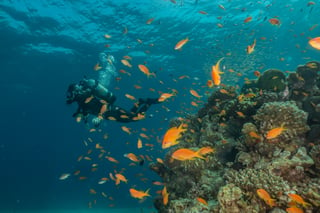The Red Sea is renowned as one of the premier diving destinations in the world, offering a captivating underwater experience with its diverse marine life and stunning coral reefs. This guide will provide you with essential information on diving in the Red Sea, including the best time to visit, top dive sites, necessary gear, and local customs.

Why Dive in the Red Sea
The Red Sea boasts an astonishing array of marine biodiversity, making it a diver's paradise. Here are some key reasons why it's a must-visit destination for divers:
Rich Marine Life
The Red Sea is home to over 1000 species of fish and 150 species of coral. The absence of frequent storms allows the corals to flourish, creating intricate and beautiful underwater landscapes. These corals are also notably resistant to bleaching.
Diverse Marine Species
Divers can encounter a variety of marine species in the Red Sea, including turtles and sharks. Hammerhead sharks are a common sight in the southern region, especially during the summer months.
Oceanic White Tip sharks are more likely to be spotted in the winter. Djibouti is a prime location for whale sharks, with the best time to visit being from November to January. Manta rays can be observed in Sudan from September to November, as well as thresher sharks in both Sudan and Egypt.
Calm Waters and Ideal Conditions
The Red Sea experiences consistent water temperatures, ranging from a low of 20°C in February to 31°C in September, making it suitable for diving year-round.
The calmest waters are often during the full moon, and the low season for diving is December to February due to cooler water temperatures and June to August because of the heat.
Unique Geological Features
The Red Sea is part of the Great Rift Valley, resulting in an exceptionally deep sea, reaching depths of nearly 3000 meters. This geological feature has led to the formation of intriguing dive sites, such as the Brothers, which are steep-sided islands likely formed by volcanic activity as the rift opened.
Best Places to Dive in the Red Sea
The Red Sea offers numerous captivating dive sites. Here are the top ten dive sites as voted by divers:
- Thistlegorm, Egypt:
- Located near the Sinai Peninsula, the Thistlegorm is a famous World War II shipwreck. Diving here offers a glimpse into history, with well-preserved artifacts and marine life surrounding the sunken vessel.
- Shark and Yolanda Reef, Egypt:
- This dive site is renowned for its stunning coral gardens and the chance to encounter a variety of sharks, including reef sharks and hammerhead sharks. The Yolanda wreck adds an extra layer of intrigue to the dive.
- Elphinstone Reef, Egypt:
- Elphinstone Reef is a magnet for divers seeking encounters with oceanic white-tip sharks and hammerhead sharks. The sheer walls of the reef, covered in colorful corals, provide an awe-inspiring backdrop.
- Big Brother, Egypt:
- Big Brother Island is home to two shipwrecks, the Aida and the Numidia, both offering unique diving experiences. The site is famous for its pelagic encounters and coral-covered wrecks.
- Sha'ab Rumi South, Sudan:
- Located in Sudan, this site is renowned for its abundance of marine life. Divers can expect to see schools of fish, pelagics, and even hammerhead sharks, making it a must-visit for advanced divers.
- Blue Hole, Dahab, Egypt:
- The Blue Hole is a world-famous dive site known for its dramatic underwater sinkhole. Divers can descend through an archway into the abyss, where colorful corals and marine life await.
- Jackson Reef, Egypt:
- Located in the Tiran Strait, Jackson Reef is famous for its coral formations, teeming with marine life. Strong currents attract large schools of fish and pelagic species, creating an exhilarating dive experience.
- Daedelus, Egypt:
- Daedelus Reef is a remote outpost in the Red Sea and offers pristine diving conditions. Divers can encounter various shark species, including hammerhead sharks, as well as vibrant coral gardens.
- St John's, Egypt:
- St. John's Reef is known for its stunning coral formations and the chance to spot pelagic species. This remote reef system offers tranquility and unparalleled underwater beauty.
- Little Brother, Egypt:
- Adjacent to Big Brother Island, Little Brother is famous for its shark encounters, including hammerheads and oceanic white-tip sharks. The coral-covered walls provide a vibrant backdrop for these thrilling encounters.
These sites offer diverse underwater experiences, from exploring shipwrecks to encountering vibrant coral reefs and marine life.
Dive Gear and Wetsuits
When diving in the Red Sea, it's essential to have the right gear. Given the average dive duration of around an hour, wearing a wetsuit is recommended. The thickness of your wetsuit should vary depending on the season:
- Summer Months: A 5 mm wetsuit is suitable.
- January and February: For those sensitive to cold, a 7 mm wetsuit with a hood is advisable.
Diving in Egypt
Egypt is a popular starting point for Red Sea diving due to its accessibility and excellent diving infrastructure. Here are some important details for diving in Egypt:
- Tourist Visa: Upon arrival, you'll need to purchase a tourist visa for $25. Alternatively, you can pay in Euros or Egyptian pounds. Keep in mind that the entry fee may be subject to change.
- Tipping Culture: Egypt has a culture of tipping, and it's customary to tip service providers. Here's a rough guide for tipping per person:
- Driver taking you to the hotel: 20 Egyptian pounds (LE)
- Dive guides and boat staff: 10% of dive costs
- Waiters: 10 LE per meal (if no service charge is included)
- Housekeeping: 10 LE per night
- Luggage porter in the hotel: 10 LE per bag
- Taxi drivers (if helpful): At least 10 LE
When tipping, do so discreetly by folding the money in your palm and passing it across.
Additionally, don't be surprised if locals ask you to exchange coins for banknotes, as banks often only accept notes, and this can be a helpful service for them.
Diving in the Red Sea is a remarkable experience, offering a glimpse into the vibrant and diverse underwater world. Whether you're an experienced diver or a novice, this destination promises unforgettable adventures beneath the waves.


To help us improve